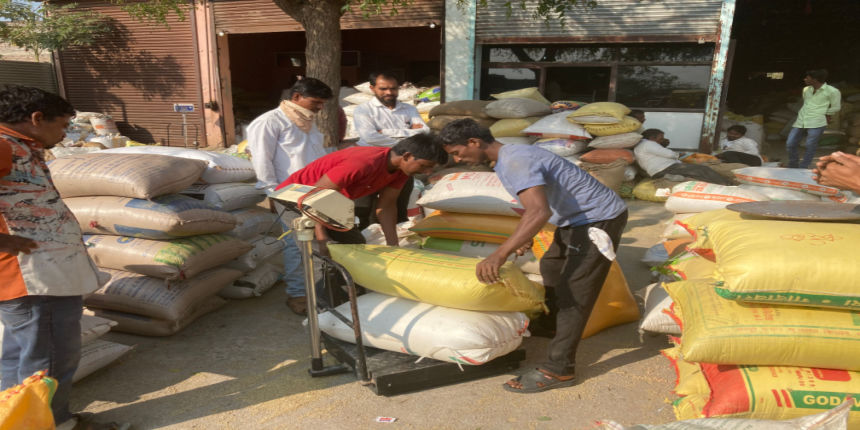APMC Full Form
What is the Full Form of APMC?
The Mandi system: Agricultural Produce Market Committees (APMC) is a marketing organisation set up by state governments to stop instances of farmers being exploited by middlemen and compelled to sell their produce at extortionate prices.
The market must receive all the food products, and transactions are conducted by an auction. Mandi, the market, is put up at various locations around the states. The state is geographically divided by these marketplaces. The traders are given licences to operate in a market. The owners of malls, wholesalers, and retailers are prohibited from making direct purchases of produce from farmers.
- What is the Full Form of APMC?
- APMC and e-NAM
- Core Values Of APMC
- Model APMC Act 2003:
- Shortcomings of APMC:

In order to create a unified national market for agricultural commodities, the National Agriculture Market (NAM), a pan-Indian electronic trading site, connects the Agricultural Produce Market Committee (APMC) mandis that already exist throughout the nation.
APMC and e-NAM
All APMC-related information and services are available through a single window on the e-NAM portal, including the following:
Commodities' arrivals and prices
Offers to purchase and sell
Responding to trade offers is one of the services offered.
The NAM reduces transaction costs and information irregularity even as agricultural produce continues to flow through the mandis.
According to its agri-marketing regulations, which specify that the State is divided into various market zones, each of which is governed by a separate APMC and will enforce its own marketing standards, the states can regulate agriculture marketing.
Core Values Of APMC
The following key tenets underlie how the APMC functions:
Preventing money lenders—also known as intermediaries—who force farmers to sell their produce at low prices from exploiting Indian farmers.
Farmers' produce must first be transported to a market before being auctioned off.
Every state government in India operates an APMC market where farmers can sell their produce at auction in a number of locations within their borders.
Retail and wholesale traders, such as the owners of shopping centres and food processing businesses, cannot directly purchase the produce of farmers even though they are required to have a licence in order to operate within a market or a mandi.
Model APMC Act 2003:
The model APMC Act states that a farmer is exempt from bringing his produce to APMC Mandi.
Anybody the farmer chooses can purchase his produce directly.
However, he cannot run for election to that APMC marketing committee if he does not deliver his produce to the mandi.
Alternative markets like direct purchase centres, private market yards/mandis, etc. are permitted by the model Act.
APMCs' increased accountability: Provisions including full payment, promoting private partnerships in APMC management, and displaying the amount carried and the pricing close to the entry gate.
The 'State Agricultural Produce Marketing Standards Bureau' for Grading, Standardization, and Quality Certification must be established, according to the model Act.
Contract farming is made possible by the Model Act.
sales of certain agricultural commodities in any market area are subject to a single point of market taxation.
Additionally, provisions were developed for settling disagreements between the parties.
The Model Act allows for the development of marketing infrastructure using APMC money.
Shortcomings of APMC:
Monopoly of APMC: One of the most important problems is the monopoly of APMC, which has denied farmers access to better clients and consumers access to original providers.
Cartelization is the term used to describe monopoly among a select few. APMC employees band together to form a cartel and consciously refrain from making larger offers.
Thus, the produce is bought at a price that was artificially discovered and then sold for more money.
Entry Obstacles: These markets have extremely high licence fees. Additionally, in addition to the licence cost, the high rent and value of the establishments has discouraged competition.
Due to this, only a select segment of the rural or metropolitan elite often operates in APMC. For instance, politicians oversee a significant number of APMCs in northern India.
Conflict of Interest: The APMC serves as both a market supplier and a regulator.
Vested interests in trade weaken its ability to act as a regulator. The agents working in that market are more frequently used to nominate and elect members and the chairman.
High commission, marketing fees, and APMC cess are all paid by farmers, which drives up the price of produce.
Frequently Asked Questions (FAQs)
The Agriculture Produce Market Committee was established by the state governments of India in accordance with the Agriculture Produce Marketing Regulation Act.
The APMCs regulate about 2000 regulated APMC market yards and over 4000 sub-market yards. 1000 APMC markets from 18 Indian states and 3 Union territories are concurrently directly connected to the e-NAM (electronic National Agricultural Market) network.
The agricultural trading laws that have produced these advantages are governed by APMC:
By lowering market fees, APMC increased market efficiency.
The pointless intermediates were eliminated by APMC.
The seller and producer interests will be fairly protected, according to APMC.
The agricultural market produce committee markets currently charge a market fee of.35%, but traders still want it to be lowered to.20%.
The shortcoming of APMC are:
1. Monopolistic Strategy
2. Restricted Entry Cartel Formation
3. APMC Cess, Marketing Fee, and Commission